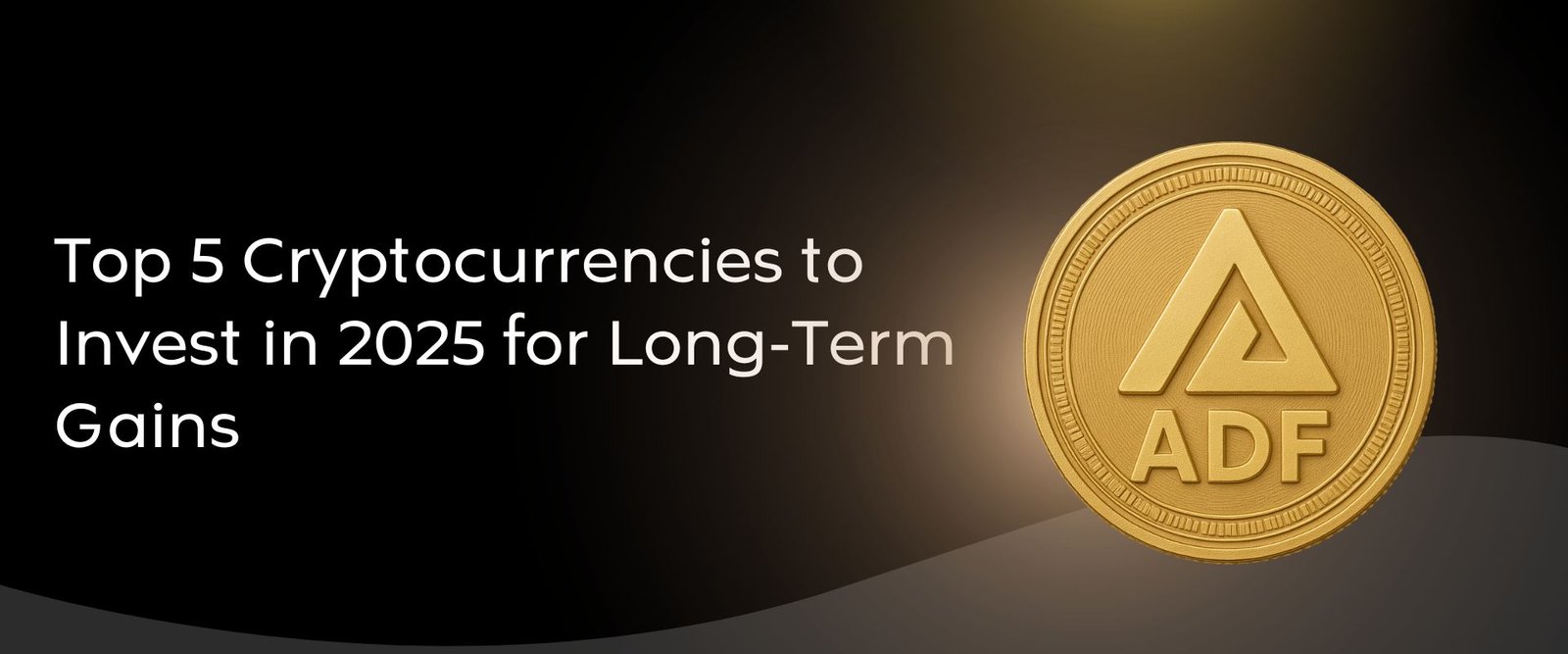Blog
Top 5 Cryptocurrencies to Invest in 2025 for Long-Term Gains

The cryptocurrency market continues to evolve rapidly, presenting both opportunities and challenges for long-term investors. As we navigate through 2025, identifying the most promising digital assets for sustained growth becomes crucial for building a robust crypto portfolio. This comprehensive analysis examines five cryptocurrencies that demonstrate strong potential for long-term gains based on technology, adoption, and market fundamentals.
Understanding Cryptocurrency Investment in 2025
The crypto landscape in 2025 is markedly different from previous years, with increased institutional adoption, clearer regulatory frameworks, and improved blockchain technology. Smart investors are focusing on projects with real-world utility, strong development teams, and sustainable tokenomics rather than speculative hype.
Key factors driving cryptocurrency success in 2025 include:
- Regulatory clarity and compliance
- Real-world adoption and utility
- Technological innovation and scalability
- Institutional investment and partnerships
- Community support and ecosystem development
Top 5 Cryptocurrencies for Long-Term Investment
The following cryptocurrency selections are based on comprehensive market analysis, technological innovation, adoption rates, and long-term growth potential. These digital assets represent diverse blockchain ecosystems with proven utility, strong development teams, and sustainable tokenomics. Each cryptocurrency offers unique investment opportunities for portfolio diversification and wealth building strategies.
Bitcoin (BTC) – The Digital Gold Standard
Bitcoin remains the king of cryptocurrencies and continues to be the most trusted store of value in the digital asset space. With growing institutional adoption and recognition as digital gold, BTC offers stability and long-term appreciation potential.
Key strengths of Bitcoin:
- First-mover advantage and brand recognition
- Limited supply of 21 million coins
- Institutional backing from major corporations
- Store of value characteristics
- Network security and decentralization
Bitcoin’s role as a hedge against inflation and portfolio diversification tool makes it an essential holding for long-term crypto investors. The halving cycles and scarcity model continue to drive price appreciation over time.
Ethereum (ETH) – The Smart Contract Pioneer
Ethereum has established itself as the leading smart contract platform, powering the majority of decentralized applications (DApps), DeFi protocols, and NFT marketplaces. The successful transition to Proof of Stake has improved energy efficiency and scalability.
Ethereum’s competitive advantages:
- Largest developer ecosystem in crypto
- DeFi dominance with billions in total value locked (TVL)
- NFT marketplace leadership
- Layer 2 scaling solutions integration
- Continuous innovation and upgrades
The Ethereum ecosystem continues to expand with layer 2 solutions, enterprise adoption, and institutional interest, positioning ETH for sustained long-term growth.
Solana (SOL) – The High-Performance Blockchain
Solana has emerged as a leading high-performance blockchain capable of processing thousands of transactions per second with minimal fees. Its fast transaction speeds and low costs make it ideal for DeFi, gaming, and NFT applications.
Solana’s key features:
- Ultra-fast transaction processing (65,000+ TPS)
- Low transaction fees (fractions of a cent)
- Growing ecosystem of applications
- Developer-friendly environment
- Institutional partnerships and integrations
The Solana ecosystem continues to attract developers and projects seeking scalable blockchain solutions, driving SOL token demand and long-term value appreciation.
Cardano (ADA) – The Research-Driven Platform
Cardano distinguishes itself through academic research and peer-reviewed development. The platform focuses on sustainability, scalability, and interoperability while maintaining energy efficiency through its Proof of Stake consensus mechanism.
Cardano’s unique propositions:
- Scientific approach to blockchain development
- Energy-efficient Proof of Stake consensus
- Smart contract capabilities with Plutus
- Strong community and governance
- Focus on emerging markets and financial inclusion
ADA’s methodical approach to blockchain development and real-world applications in emerging markets position it for steady long-term growth.
ADF Coin – The Emerging Digital Asset
ADF Coin represents an emerging cryptocurrency with potential for significant growth in the evolving digital asset landscape. As an innovative blockchain project, ADF Crypto aims to provide unique solutions in the cryptocurrency ecosystem.
ADF Coin features and potential:
- Innovative blockchain technology and use cases
- Growing community and ecosystem development
- ADF Wallet integration for secure storage
- ADF Exchange compatibility for trading access
- CoinMarketCap listing for market visibility
ADF Crypto is positioned to benefit from the expanding cryptocurrency market and increased digital asset adoption. The ADF Wallet provides users with secure storage solutions, while ADF Exchange integration offers convenient trading options.
Investment recommendation. Binance, Bitget, and CoinMarketCap listings are subject to change and verification.
Investment considerations for ADF:
- Early-stage opportunity with growth potential
- Developing ecosystem and partnerships
- Community-driven development
- Market accessibility through major platforms
- Long-term vision and roadmap execution
Investment Strategies for Long-Term Success
Dollar-Cost Averaging (DCA)
Dollar-cost averaging remains one of the most effective strategies for long-term crypto investing. By investing fixed amounts regularly, investors can reduce volatility impact and build positions over time.
Portfolio Diversification
Diversifying across multiple cryptocurrencies helps spread risk and capture growth from different sectors of the crypto market. A balanced portfolio might include:
- Large-cap cryptocurrencies (Bitcoin, Ethereum)
- Mid-cap projects with strong fundamentals
- Emerging tokens with growth potential
- Sector-specific cryptocurrencies (DeFi, gaming, infrastructure)
Risk Management
Effective risk management includes:
- Position sizing based on risk tolerance
- Stop-loss strategies for downside protection
- Regular portfolio rebalancing
- Staying informed about market developments
- Long-term perspective despite short-term volatility
Market Analysis and Future Outlook
The cryptocurrency market in 2025 is characterized by:
- Increased institutional adoption and regulatory clarity
- Growing utility and real-world applications
- Technological improvements and scalability solutions
- Mainstream acceptance and payment integration
- Innovation in DeFi, NFTs, and Web3 technologies
Long-term investors should focus on fundamental analysis, technology adoption, and market trends rather than short-term price movements.
Key Considerations for Crypto Investors
Regulatory Environment
Regulatory developments significantly impact cryptocurrency markets. Investors should monitor:
- Government policies and legislation
- Compliance requirements and reporting obligations
- Tax implications of crypto investments
- Exchange regulations and security standards
Technology and Innovation
Blockchain technology continues evolving with:
- Improved scalability solutions
- Enhanced security protocols
- Better user experience and interfaces
- Interoperability between different blockchains
- Sustainable consensus mechanisms
Market Volatility
Cryptocurrency markets remain volatile, requiring:
- Strong risk tolerance and emotional discipline
- Long-term investment horizon
- Diversification strategies
- Regular portfolio monitoring
- Continuous education about market dynamics
Conclusion
Long-term cryptocurrency investing in 2025 requires careful selection of digital assets with strong fundamentals, real-world utility, and growth potential. The five cryptocurrencies discussed – Bitcoin, Ethereum, Solana, Cardano, and ADF Coin – represent different approaches to blockchain innovation and value creation.
Bitcoin and Ethereum provide stability and proven track records, while Solana and Cardano offer technological innovation and scalability. ADF Coin represents an emerging opportunity with growth potential in the evolving crypto landscape.
Successful long-term investing requires patience, discipline, and continuous learning. Investors should conduct thorough research, manage risks appropriately, and maintain long-term perspectives despite market volatility.
Remember that cryptocurrency investing carries significant risks, and past performance doesn’t guarantee future results. Always invest responsibly and consider consulting with financial advisors before making investment decisions.
Blog
Looking for a GCS Crypto Currency Licence and Registration in Dubai?

Looking for a GCS Crypto Currency Licence and Registration in Dubai?
Welcome to our guide on Crypto currency license in Dubai. At GCS, we specialize in providing top-quality Crypto currency license services to meet your needs.
Why Choose Our Crypto currency license Services?
Our team of experienced professionals understands the importance of quality Crypto currency license in Dubai. We pride ourselves on delivering exceptional results and customer satisfaction.
Our Approach to Crypto currency license
We take a comprehensive approach to Crypto currency license, ensuring that every aspect of our service meets the highest standards. Our process includes:
- Thorough consultation to understand your specific needs
- Customized solutions tailored to your situation
- Ongoing support throughout the process
- Transparent communication at every step
Important Resources
For more information about Crypto currency license, check out these valuable resources:
- Crypto Currency Licence in Dubai
- Dubai Crypto Currency Licence
- Crypto Currency Registration in Dubai
- Dubai Crypto Currency Registration
- GCS Crypto Currency Licence in Dubai
Get Started Today
Ready to experience the difference our Crypto currency license services can make? Contact GCS today to schedule your consultation. Our team is standing by to answer your questions and help you get started on the path to success.
Don’t wait – reach out to us today and discover why so many people in Dubai trust GCS for their Crypto currency license needs.
Blog
Best Crypto currency license Services in Dubai

Best Crypto currency license Services in Dubai
Welcome to our guide on Crypto currency license in Dubai. At GCS, we specialize in providing top-quality Crypto currency license services to meet your needs.
Why Choose Our Crypto currency license Services?
Our team of experienced professionals understands the importance of quality Crypto currency license in Dubai. We pride ourselves on delivering exceptional results and customer satisfaction.
Our Approach to Crypto currency license
We take a comprehensive approach to Crypto currency license, ensuring that every aspect of our service meets the highest standards. Our process includes:
- Thorough consultation to understand your specific needs
- Customized solutions tailored to your situation
- Ongoing support throughout the process
- Transparent communication at every step
Important Resources
For more information about Crypto currency license, check out these valuable resources:
- Crypto Currency Licence in Dubai
- Dubai Crypto Currency Licence
- Crypto Currency Registration in Dubai
- Dubai Crypto Currency Registration
- GCS Crypto Currency Licence in Dubai
Get Started Today
Ready to experience the difference our Crypto currency license services can make? Contact GCS today to schedule your consultation. Our team is standing by to answer your questions and help you get started on the path to success.
Don’t wait – reach out to us today and discover why so many people in Dubai trust GCS for their Crypto currency license needs.
Blog
Dubai 2025: The Tech Revolution Unveiled – From Smart Cities to AI‑Driven Innovation
Dubai has always been a city that looks toward the future. From its iconic skyline to its ambitious plans for sustainability, the spirit of innovation is woven into every project. In 2025, the city is stepping into a new era where technology is not just a tool but a living system that powers everyday life, reshaping how residents work, travel, shop and connect.
1. The Birth of a Smart City
When most people think of a smart city, images of connected traffic lights, billboards that update in real time, and drones delivering packages come to mind. Dubai’s journey began with the Smart Dubai programme, which set out to create a city where digital services are delivered more efficiently and transparently. The programme’s core goals were:
- Digital identity for citizens and residents.
- Integrated data platform for city services.
- Smart infrastructure that adapts to real‑time needs.
- Encouragement of start‑ups and tech investment.
These pillars laid the groundwork for a city that can react to the needs of its people instantly, making daily life smoother and more rewarding. This foundation also helped launch a wave of projects that pushed Dubai ahead of the global curve.
2. Artificial Intelligence Takes the Driver’s Seat
Artificial Intelligence (AI) has become the engine behind many of Dubai’s newest achievements. From predictive policing that helps keep streets safe to AI‑powered logistics that reduce delivery times, the technology is changing every sector.
Transportation and Mobility
The Dubai Metro’s robots now run maintenance checks without human intervention. Autonomous buses navigate the sidewalks, delivering passengers between business districts with minimal delays.
Healthcare Revolution
AI algorithms predict potential health risks based on lifestyle and genetic data, allowing doctors to intervene early. Virtual consultations powered by AI chatbots provide instant medical advice, freeing up specialists for complex cases.
Public Safety and Law Enforcement
Machine‑learning models detect unusual crowd movements and highlight potential security threats before they grow. Law‑enforcement drones patrol the city, ensuring that emergency response is swift and efficient.
By embedding AI into everyday services, Dubai turns its metropolis into a responsive organism that learns and grows with its people.
3. Blockchain: The Invisible Ledger of Modern Life
While blockchain has made headlines in finance, its real power lies in its transparency and security. Dubai has leveraged the technology to create tamper‑proof systems across government, healthcare, and logistics.
One notable example is the Digital Health Pass—an immutable record that tracks vaccination, medical history, and health alerts. Similarly, property transactions are recorded on a blockchain, cutting down paperwork and fraud while speeding up closing times.
These applications not only add value for the government but also provide a sense of trust for residents and investors alike.
4. The Architecture of Tomorrow: Smart Skyscrapers and Infrastructure
Dubai’s skyline is home to more than just office space; it is a living laboratory for sustainable design. Buildings now incorporate:
- Energy Harvesting Windows: Transparent solar panels that provide electricity to the building’s systems.
- Responsive Facades: Skin that adjusts to sunlight and temperature, keeping interiors comfortable while lowering energy usage.
- Water Recycling Systems: On‑site purification that reduces municipal water demand.
These features not only reduce carbon footprints but also lower operational costs, making high‑rise living accessible to a wider audience.
5. Technology Hubs and the Start‑up Ecosystem
The city’s growth is driven partly by its vibrant ecosystem for technology start‑ups. Numerous incubators provide mentorship, financing, and access to venture capital. Key areas of focus include:
- FinTech solutions simplifying banking for the cloud‑native generation.
- EdTech platforms that bring personalized learning to anyone on the move.
- HealthTech that integrates wearable data with AI diagnostics.
- Supply chain technology creating end‑to‑end traceability.
Dubai’s open data initiatives give start‑ups a wealth of information—making it easier to test and scale products that fit the local market and can also export worldwide.
6. The Human Touch: Building Tech Culture
Innovation is only as good as the people behind it. Dubai invests heavily in human capital: from schools teaching coding from kindergarten to higher‑education programmes that put AI and blockchain at the forefront.
Workshops lead residents to create their own mini‑projects, giving them a sense of ownership over the urban digital narrative. These efforts foster a public appetite for technology, ensuring that the next wave of ideas will come from diverse voices.
7. Looking Ahead: What Lies Beyond 2025?
The ambition never stops. While 2025 has delivered massive strides, the sights are now set on a more interconnected yet sustainable system.
- Zero‑carbon buildings enabled by nanomaterials.
- Hyper‑fast transport links into the desert, turning islands into bustling hubs.
- Advanced AI that helps residents live healthier lifestyles by predicting needs.
- Fully autonomous commercial districts where order and efficiency thrive.
These future projects are based on data collected in real time, meaning the city can adapt quickly to changing aspirations.
Dubai’s transformation demonstrates how creating a digital ecosystem, backed by supportive policy, can accelerate progress for all residents and set a global example for future city planning.
Want to read more about how Dubai is turning skyscrapers into AI hubs? Explore our story on skyscraper AI transformation.
Curious how the city’s smart system uses AI and blockchain to improve everyday life? Dive into the pulse of Dubai’s tech evolution.
Still wondering how visionary dreams turned into a reality of smart cities and AI? Discover the journey of Dubai’s tech pulse.
-

 Business2 years ago
Business2 years agoTop 10 Highest-Paying Jobs in Dubai for 2024-25
-

 Business2 years ago
Business2 years agoTop 10 Business Opportunities in Dubai for 2024-2025
-

 Business2 years ago
Business2 years agoBest upcoming exhibitions and trade shows in Dubai, 2024
-

 Business1 year ago
Business1 year agoHow Much Does It Cost to Open a Company in Dubai in 2024?
-

 Sports2 years ago
Sports2 years agoTop 5 Upcoming International Sporting Events in Dubai (2024-2025)
-

 Blog2 years ago
Blog2 years agoPlaces to Visit in Ras Al Khaimah
-

 Business2 years ago
Business2 years agoTop 5 Networking Events for Businesses in Dubai in 2024
-

 Latest3 months ago
Latest3 months agoDubai Golden Visa 2025: Everything You Need to Know About Eligibility, Benefits and Application Process



